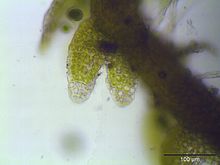Cephaloziella divaricata
| Cephaloziella divaricata | ||||||||||||
|---|---|---|---|---|---|---|---|---|---|---|---|---|

Cephaloziella divaricata |
||||||||||||
| Systematics | ||||||||||||
|
||||||||||||
| Scientific name | ||||||||||||
| Cephaloziella divaricata | ||||||||||||
| ( Sm. ) Schiffn. |
Cephaloziella divaricata (in German also Spreizblättriges Kleinkopfsprossmoos ) has a broad ecological amplitude and can survive dehydration quite well. It is a dioecious , extremely tiny, leafy liverwort and is often overlooked.
Occurrence
Cephaloziella divaricata mainly colonizes light and dry locations. It prefers acidic, low-lime humus soils. However, it can also be found on over-earthed rock and on sandy to loamy earth places. It often grows together with Ceratodon purpureus , Hypnum cupressiforme sl, Dicranella heteromalla , Campylopus flexuosus and Racomitrum heterostichum .
Identifying features
The moss forms prostrate or slightly rising, dark green to brownish plants that can be grass-shaped or interspersed between other mosses. They are only up to 1 cm long and about 0.7 mm wide. The scion has some scattered rhizoids (stolons). The leaves, which are roughly half divided into two lobes, are 45 ° across and upright on the shoot. The base of the leaf lobes is 5 to 9 slightly thickened cells wide, which can be about 8 to 20 µm long and 10 to 15 µm wide. The species can be distinguished from the other Cephaloziella species by the ever-present sub-leaves, which can vary greatly in shape and size. Female plants develop sharp bracts. Often there are two-celled, green to brown colored brood bodies with an average size of around 15 to 25 µm.
literature
- Nebel, Philippi: Die Moose Baden-Württemberg Volume 3 (Ulmer Verlag, 1st edition, 2005 ISBN 3-8001-3278-8 )
- Jan-Peter Frahm , Wolfgang Frey , J. Döring: Moosflora . 4th, revised and expanded edition (UTB for Science, Volume 1250). Ulmer, Stuttgart 2004, ISBN 3-8001-2772-5 (Ulmer) & ISBN 3-8252-1250-5 (UTB)

